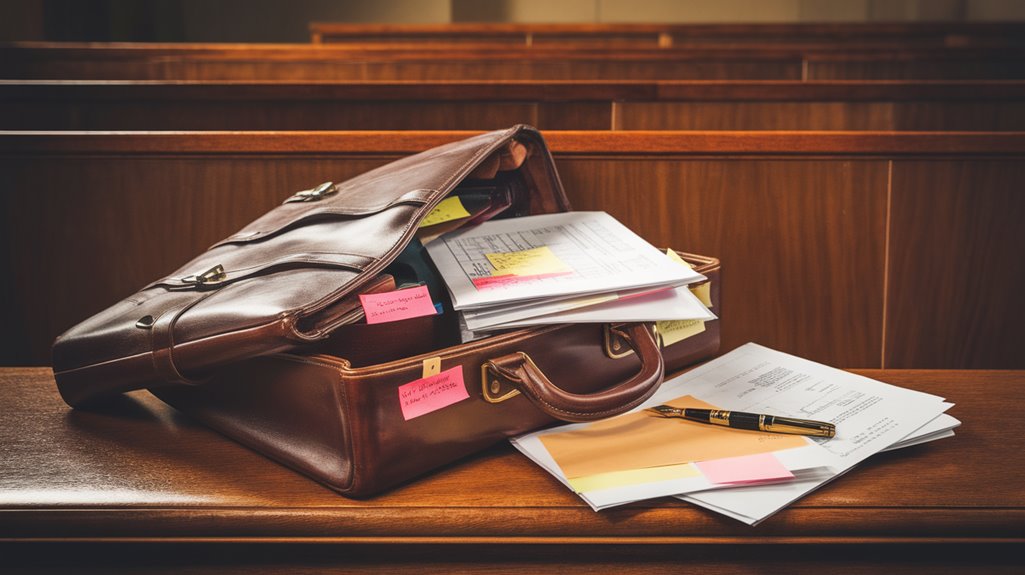Party-opponent admissions can transform legal arguments when used strategically. Attorneys must properly identify, authenticate, and time the presentation of opponent statements for maximum impact. Key strategies include using pre-trial motions, cross-examination sequences, and narrative frameworks to build credibility. Ethical considerations and proper documentation remain essential for leveraging admissions effectively. The thoughtful application of these techniques creates powerful arguments that can greatly influence case outcomes.
Key Takeaways
- Strategic timing of opponent admissions during cross-examination maximizes impact, with key revelations saved for critical moments in testimony.
- Authenticate opponent statements through proper documentation, witness verification, or electronic validation to ensure admissibility in court.
- Transform admissions into compelling narrative elements by connecting them logically to case law and presenting them in relatable scenarios.
- Use pre-trial motions effectively to challenge or leverage opponent admissions while adhering to local rules and deadlines.
- Build credibility by presenting opponent admissions fairly and ethically, focusing on legitimate fact-finding rather than procedural manipulation.
The Foundational Elements of Party-Opponent Admissions

Party-opponent admissions serve as essential evidence in legal proceedings. These admissions fall into several key categories that create evidential foundations for cases. The most direct form comes from a party's own statements. Other types include adopted statements through actions or silence, and authorized representations by corporate officers.
The legal system recognizes these party statements without requiring typical hearsay exceptions. They must be authenticated and offered against the opposing party to be admissible. Unlike other evidence types, party admissions don't need the declarant's testimony or special reliability showings. This makes them powerful tools in both civil and criminal cases. The framework allows for broad application while maintaining basic authentication standards under Federal Rule of Evidence 901(a).
Identifying Admissible Statements in Discovery
Successful discovery requires careful screening of potential admissions against key criteria. Attorneys must evaluate statements for both admissibility and strategic value while maneuvering through hearsay exceptions and preparing evidentiary rebuttals. This process involves analyzing authenticity, privilege status, and relevance to claims.
| Screening Factor | Key Requirements | Common Pitfalls |
|---|---|---|
| Authentication | Witness testimony or metadata | Missing chain of custody |
| Privilege Status | No attorney-client content | Inadvertent waivers |
| Relevance | Direct link to claims | Overly broad scope |
| Format Rules | Verbatim reproduction | Incomplete context |
Courts expect proper documentation of opponent admissions through witness verification or electronic validation. Successful identification requires balancing probative value against potential prejudice while maintaining procedural compliance. Each statement must meet basic authentication standards and avoid privilege violations.
Strategic Timing for Admission Presentation

Attorneys must decide when to present opponent admissions across different stages of litigation. Key timing options include filing pre-trial motions to exclude expert testimony, incorporating admissions into cross-examination sequences, and saving impactful statements for rebuttal. Each timing choice serves distinct strategic purposes and requires careful planning to maximize the admission's persuasive value.
Pre-Trial Motion Selection
Strategic timing of pretrial motions can make or break admission challenges. Effective motion strategies start with suppression requests filed after key discovery reveals constitutional violations. This approach prevents premature exposure of defense tactics while maintaining trial efficiencies.
Attorneys must coordinate admission challenges with co-defendant issues, especially for pattern-of-conduct exclusions. Courts prefer hearing admission matters tied to new exculpatory evidence. Early filing is essential for motions requiring evidentiary hearings, like those involving audio recordings.
Success often depends on balancing proactive and delayed approaches. While some admissions warrant immediate action, others benefit from strategic delays until trial. However, lawyers must watch filing deadlines to avoid procedural forfeitures, typically due 30 days before trial.
Cross-Examination Sequence Planning
The timing of admission presentation during cross-examination shapes case outcomes. Attorneys must plan their sequence carefully to maximize impact while maintaining control. The most effective cross examination techniques start with easy, uncontested facts to build momentum before addressing critical admissions.
Witness reliability determines whether to follow a chronological or thematic approach. Less reliable witnesses often require thematic questioning to highlight contradictions. Smart sequencing includes mixing admission-seeking questions with neutral ones to maintain jury attention. Key admissions should be saved for later in the examination when the witness's credibility has been properly challenged.
Attorneys must also stay flexible and ready to abandon planned sequences if the witness proves too rehabilitative or risky for further questioning.
Rebuttal Phase Deployment
When timed effectively, admission presentations during the rebuttal phase can greatly impact case outcomes. Success rates show that carefully planned rebuttal phase strategies markedly influence final determinations, with 79% of provider rebuttals failing under review.
Opponent admissions analysis must account for the strict 30-day window, where providers must either concede or contest challenges. The automated tracking system enforces deadlines without exception, making timing essential. Early submissions allow for corrections during the Challenge Phase, while late rebuttals risk automatic disposition. Evidence bifurcation requires separate filings for multiple locations, demanding precise documentation management. Smart deployment leverages the automated notification system to track dispute status and synchronize responses, maximizing the impact of admission presentations within procedural constraints.
Building Credibility Through Opponent Declarations

Strategic use of opponent declarations can boost a case's credibility in powerful ways. When lawyers quote their opponents' own words, it creates a sense of fairness and honesty that resonates with judges and juries. The careful selection and timing of admission revelations allows attorneys to build trust while simultaneously highlighting the strongest elements of their arguments.
Authenticity Builds Trust
Authenticity forms the cornerstone of legal credibility. Through authentic communication, attorneys build lasting trust with judges and juries by openly acknowledging case vulnerabilities rather than attempting to conceal them. This transparent approach helps disarm natural skepticism toward lawyers who might appear overly polished or strategic.
Trust elevation occurs when legal teams demonstrate integrity by voluntarily exposing relevant evidence and addressing opposing arguments head-on. By contrasting their forthright behavior with opponents who may withhold information, attorneys establish themselves as reliable actors in the courtroom. This ethical alignment extends to respecting procedural rules and avoiding exploitative tactics, even during adversarial moments. The resulting credibility stems not from clever maneuvering but from a consistent commitment to truthful, direct engagement with the facts at hand.
Strategic Quote Selection
The careful selection of opponent admissions amplifies legal credibility. Legal teams must focus on statements that directly support their position while maintaining contextual relevance. Strategic language choices matter when presenting these admissions to courts and arbitrators.
Practitioners should prioritize quotes from authoritative sources, especially executive-level officials or key decision-makers. Clear, unambiguous statements carry more weight than complex interpretations. When possible, pair contradictory admissions to highlight inconsistencies in opposing arguments.
Simple presentation techniques enhance impact. Lead with strong action verbs and provide clear attribution for each quote. Complex admissions should be paraphrased into plain language while preserving their essential meaning. This approach helps judges and juries grasp key points quickly while maintaining the credibility of the argument.
Timing Admission Revelations
Timing plays an essential role when revealing opponent admissions in legal proceedings. Understanding key timing nuances helps attorneys maximize the impact of these declarations while meeting critical deadlines. Rule 29 motions must be filed at the close of prosecution evidence, while Rule 33 motions for newly discovered evidence have a three-year window.
Effective admission strategies require careful attention to procedural benchmarks. Attorneys must file Rule 33 motions based on legal error within 14 days post-verdict to preserve appellate rights. The FRE 401(a) relevance threshold guides when to introduce evidence directly tied to material facts. Additionally, UK prosecutors must receive unused materials schedules during pre-plea stages to align with AG Guidelines disclosure requirements. These timing considerations help build credible legal arguments while maintaining procedural compliance.
Maximizing Impact in Cross-Examination

Strategic cross-examination requires careful planning to maximize opponent admissions while staying within jurisdictional bounds. Understanding cross examination dynamics helps attorneys leverage admissions effectively while avoiding scope violations. Most courts limit questioning to topics covered in direct examination, though Massachusetts allows broader inquiry. Strategic questioning must balance impeachment opportunities with procedural constraints.
- Focus questions on prior inconsistent statements and verified Rule 36 admissions to quickly establish key facts.
- Use leading questions to test witness credibility while staying within jurisdictional scope limits.
- Authenticate online admissions through metadata and contextual evidence before presentation.
The careful timing of admission revelations during cross can greatly impact jury perception while maintaining procedural compliance. Tenant rights and protections remain critical when challenging wrongful eviction claims, ensuring that all legal safeguards are adhered to. Authentication and foundation requirements remain critical for online and documentary evidence.
Document Authentication via Party Admissions
Party admissions offer a powerful method for authenticating documents in litigation. Under Rule 801(d)(2), statements made by opposing parties bypass traditional hearsay objections. This includes both verbal statements and party conduct, such as responding to or sharing social media posts.
Authentication can occur through explicit acknowledgment or implicit adoption. When parties use documents in pleadings or fail to contest their accuracy, they create binding admissions. Digital evidence requires additional steps, like metadata analysis and IP tracking, to establish authenticity. Statements by authorized representatives, including employees and legal counsel, also qualify as admissions when made within their scope of authority. This streamlined approach to authentication helps lawyers efficiently establish document validity without relying on conventional hearsay exceptions.
Electronic Communications as Binding Statements

Electronic communications now carry the same legal weight as traditional written documents. Under the E-Sign Act, text messages, emails, and digital agreements can create binding contracts when they meet basic requirements. Electronic signatures and clear statements of agreement make these communications legally enforceable in court.
- Text messages that show clear intent and acceptance can form valid contracts
- Email exchanges containing offer and consideration become binding agreements
- Digital communications with proper notice of terms create enforceable obligations
For electronic admissions to hold up in court, they must demonstrate the standard elements of contract formation. This includes a clear offer, acceptance, consideration, and intent to be bound. Courts now treat electronic records the same as paper documents when evaluating admissions and contractual obligations.
Navigating Multiple Party Admissions
Managing admissions becomes complex when multiple parties are involved in litigation. Co-defendant implications require careful analysis of whether statements qualify as joint admissions under conspiracy rules or remain isolated to individual parties. Courts assess admission scope by examining the relationship between defendants and the context of their statements.
A key distinction exists between standard party admissions and co-conspirator statements. While one defendant's admissions typically cannot implicate others, conspiracy evidence creates exceptions. Lawyers must establish the conspiracy's timeline and objectives before introducing joint admissions. Digital communications between multiple parties need authentication through metadata or affidavits. Cross-examination strategies should avoid confusing individual admissions with conspiracy evidence, as this can lead to reversible error at trial.
Pre-Trial Motion Practice With Opponent Statements

Strategic timing of pre-trial motions can maximize the impact of opponent statements during early case stages. Authentication methods like affidavits and expert testimony prove critical when establishing the admissibility of these statements under evidence rules. Attorneys who document and preserve opponent admissions from the outset position themselves to file stronger motions that can shape the entire litigation process.
Timing Strategic Motion Filing
When attorneys obtain key admissions from opponents, timing becomes essential for strategic motion filing. Courts have established specific windows and procedures for leveraging these admissions effectively. Understanding timing considerations and strategic implications helps lawyers maximize the impact of opponent statements.
Key timing strategies include:
- Early evidence challenges using pretrial admissions can trigger expedited review under FRCP 12(b)(3)
- Courts may fast-track motions containing opponent admissions through sealed proceedings
- Post-deadline filings may be permitted when new admissions emerge, requiring amended motions under Rule 59(e)
Local rules vary by district, requiring careful attention to jurisdiction-specific requirements. Attorneys must also consider different deadlines for interlocutory appeals and summary judgment motions when planning their strategic filing approach. Quick action on newly discovered admissions often proves vital for success.
Authentication Methods Matter Most
Proper authentication of opponent statements stands as a critical foundation for pre-trial motion practice. Attorneys must meet evidentiary standards through strategic methods that establish document validity. Rule 36 Requests for Admissions offer efficient paths to secure opponent acknowledgments, while judicial notice accelerates validation for public records.
| Method | Impact |
|---|---|
| Rule 36 Admissions | Eliminates need for trial testimony |
| Judicial Notice | Fast-tracks public record acceptance |
| Expert Affidavits | Validates electronic evidence integrity |
| Witness Testimony | Confirms first-hand document creation |
Strategic handling of authentication includes attaching exhibits to pleadings and leveraging self-authenticating documents. Chain-of-custody affidavits protect physical evidence integrity without requiring stipulation. These approaches streamline pre-trial procedures while maintaining strict compliance with authentication requirements.
Preserving Statements Early
Early preservation of opponent statements requires careful timing and procedure. Initial strategies should focus on filing pre-trial motions to identify and challenge problematic statements. Preservation techniques often involve suppression motions for unconstitutional evidence and motions in limine to address admissibility concerns. Smart lawyers act quickly to meet jurisdictional deadlines and avoid waiver of key objections.
- File suppression motions before trial to challenge statements from illegal searches or seizures
- Use motions in limine to force disclosure of opponent's intended statement evidence
- Document the connection between police misconduct and challenged statements
These pre-trial steps help attorneys control opposing evidence early while maintaining Fourth Amendment protections. Quick action preserves important challenges that could otherwise be lost through procedural default.
Crafting Compelling Narrative Frameworks

A compelling narrative framework transforms opponent admissions into powerful story elements. Attorneys can maximize admission impact by weaving these statements into a cohesive storyline that resonates with decision-makers. The key is building narrative coherence through logical connections between admissions, case law, and facts.
Effective frameworks humanize abstract legal concepts by placing admissions within relatable scenarios. They use chronological sequencing to reveal patterns and employ visual aids like timelines to emphasize key points. The narrative should balance emotional elements with factual foundations, using admissions to evoke empathy while maintaining legal credibility.
Ethical Considerations in Admission Usage
Legal professionals must carefully navigate ethical boundaries when using opponent admissions. The ethical implications extend beyond basic procedural fairness, touching on issues of bias, discrimination, and tactical exploitation. Courts actively monitor admission practices to prevent abuse and guarantee justice is served rather than undermined.
- Attorneys must avoid using admissions as procedural traps, particularly against pro se litigants who may not understand complex timelines.
- Admission practices should incorporate bias prevention measures, including data anonymization and fairness audits.
- Legal teams should focus on legitimate fact-finding rather than pursuing admissions designed to increase litigation costs or create undue burdens.
These guidelines help maintain the integrity of the legal process while protecting vulnerable parties from exploitation through admission procedures. Courts consistently emphasize substance over tactical advantage in admission practices.
Preservation Techniques for Appeal Success

Successful appeals require careful preservation of legal issues during trial proceedings. A strong trial strategy focuses on documenting objections and securing rulings that protect appellate rights. Evidence preservation must follow specific requirements, including timely objections and clear legal grounds.
| Key Action | Purpose |
|---|---|
| Motion in Limine | Pre-trial preservation of evidence issues |
| Specific Objections | Clear record of legal grounds |
| Proffer Documentation | Preserve excluded evidence |
Attorneys should coordinate with appellate counsel during trial to guarantee proper preservation techniques. This includes making contemporaneous objections, preparing detailed proffers, and securing explicit rulings from the court. Post-judgment motions help strengthen the record for appeal. Documentation of all preserved issues should be systematic and thorough, following federal civil litigation requirements.
Frequently Asked Questions
Can Party-Opponent Admissions Be Used Against Co-Defendants in Criminal Cases?
Party-opponent admissions generally cannot be used against co-defendants in criminal cases unless specific exceptions apply. Co-defendant liability requires separate consideration of each defendant's case. Joint defense strategies often focus on preventing spillover effects from one defendant's statements to another. Courts typically exclude admissions made by one defendant from being used against others to protect fair trial rights and avoid prejudice.
Are Social Media Posts Considered Reliable Sources for Party-Opponent Admissions?
Social media posts can serve as party-opponent admissions, but their reliability varies. Courts examine social media credibility through multiple factors like account verification, metadata, and witness corroboration. Digital evidence reliability depends on proper authentication methods and proof of authorship. While courts generally accept authenticated social media evidence, they require sufficient proof that the alleged author actually created the post. Screenshots alone typically aren't enough without supporting documentation.
Do Admissions Made During Settlement Negotiations Qualify Under Rule 801(D)(2)?
Generally, admissions made during settlement negotiations do not qualify under rule 801(d)(2). While rule 801(d)(2) typically allows party-opponent admissions as non-hearsay evidence, Federal Rule of Evidence 408 specifically excludes statements made during settlement negotiations. This exclusion exists to encourage open dialogue and dispute resolution. However, there are exceptions for statements involving criminal conduct, fraud, or unrelated claims that may still be admissible despite occurring during settlement talks.
How Long After a Statement Is Made Can It Be Admitted?
While some worry old statements become unreliable, there is no strict time limit on admitting prior statements in court. The admissibility timeline depends on the statement context and relevance to the current case. Courts look at factors like reliability, prejudice, and probative value rather than age alone. Even decades-old statements can be admitted if they remain relevant and trustworthy, though more recent statements typically face fewer authentication challenges.
Can Statements Made by Former Employees Be Used Against Their Company?
Former employee statements can be used against a company in certain situations. These statements must be made during their employment and within the scope of their job duties to create corporate liability. Courts generally accept such evidence if the employee had authority to speak on the matter. However, statements made after leaving the company usually carry less weight unless the person had a senior role or direct knowledge of relevant facts.
Conclusion
Like a skilled archer drawing from a full quiver, attorneys must select and deploy opponent admissions with precision and purpose. When used strategically throughout litigation, these powerful statements become game-changing weapons in legal advocacy. Smart lawyers know that timing, context, and ethical handling of admissions can make or break a case. The thoughtful use of opponent statements remains one of the most effective tools for building winning arguments.
